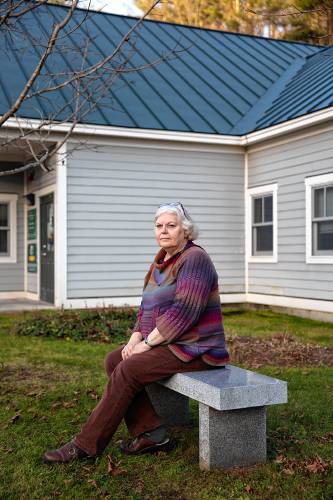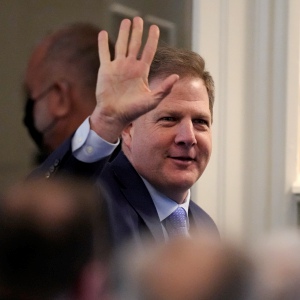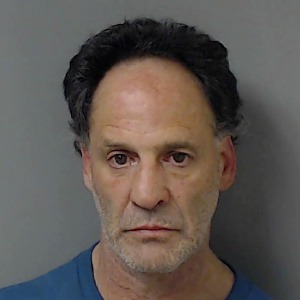Amid primary care shortage, Chelsea doctor finds new job elsewhere in Orange County

Dr. Laura Barber at the Chelsea Health Center in Chelsea, Vt., on Thursday, Nov. 16, 2023. Barber, who has worked at the center for eight years, was notified by Gifford Health Care that she is being let go effective December 15. Barber has since been hired by Little Rivers Health Care, which is headquartered in Bradford, Vt. (Valley News / Report For America - Alex Driehaus) Copyright Valley News. May not be reprinted or used online without permission. Send requests to permission@vnews.com. Valley News / Report For America — Alex Driehaus
|
Published: 02-13-2024 9:01 PM
Modified: 02-16-2024 10:26 AM |
CHELSEA — When primary care physician Laura Barber was fired from her job at the Chelsea Health Center in mid-December, town resident Will Gilman, the owner of Will’s Store, lost the doctor with whom he had a long-established trust and rapport.
Barber had worked since 2015 for Randolph-based Gifford Health Care, which is a federally qualified health center (FQHC) that operates at five locations in central Vermont. But in September, she was given 90 days’ notice and terminated on Dec. 15.
Now Gilman, a 67-year-old quadriplegic, faces a quandary. He could follow Barber to her new job as a primary care physician at Little Rivers Health Care in Bradford, Vt. — also an FQHC — which she begins April 1, or he could continue his care at the Chelsea Health Center, currently staffed by both a certified physician assistant and an advanced practice registered nurse.
“I’m looking to stay in the Gifford system. Gifford (Medical Center) is my hospital of choice,” Gilman said in a phone interview. His medical records have been in the Gifford system for, he estimated, 30 years. He likes the hospital’s smaller size, and his family and friends also use Gifford.
Gilman’s dilemma is, in some ways, emblematic of the challenges faced by patients, physicians, health care centers and hospitals in rural areas. There is a shortage of health care professionals — doctors, nurses, physician’s assistants and office support staff — who are in the field of preventive primary care, which can lead to people being turned away from routine health care at a practice or clinic or being told that the wait to see a health-care professional can be weeks or months long.
Gilman has called other health centers under the Gifford umbrella, including those in Bethel, Rochester, Randolph and Berlin, Vt. Two were not taking new patients, and the other two had waiting lists, he said. (If he required urgent care, however, he could get in to see a doctor, he said he was told.) And those clinics are a distance of 20 miles or more from Chelsea.
“The whole point is not to have to travel 20 miles,” said Gilman, who largely relies on a driver.
Without FQHCs, not-for-profit primary care clinics financially supported by the federal government to offer health care in underserved, primarily rural areas, many patients would not know where to turn, said Barber, 67, who lives in Royalton
Article continues after...
Yesterday's Most Read Articles
“Basically, a nonprofit clinic will organize and commit to providing comprehensive health care to an area — not just medical but dental, behavioral, case management and transportation,” she said.
FQHCs were first established in 1965 as part of President Lyndon B. Johnson’s War on Poverty, according to the National Institutes of Health. Patients are seen regardless of their ability to pay or whether they have health insurance. Services are offered on a sliding scale. When a clinic becomes an FQHC, “they get bonus payments to help support the clinic,” Barber said.
However, attracting health care professionals to the Upper Valley can be a tough sell, said Dr. Fay Homan, who practices at Little Rivers Health Care and is also a member of the Green Mountain Care Board’s Primary Care Advisory Group.
“Some of that is the professional isolation of working (in a rural area), and the pay for primary care is much less than for any specialty care. That’s true for MDs and nurse practitioners” Homan said.
By contrast, “specialty services provide a more predictable life. You earn more money than at the primary care level,” said Alice Ely, the executive director at the Public Health Council of the Upper Valley in Lebanon.
Even if a physician has accepted a position in the Upper Valley, Ely said, the lack of both affordable, available housing and child care is a deterrent. She has heard of young doctors who rescinded their acceptances once they realized the cost of living in the region.
The COVID-19 pandemic only exacerbated long-standing challenges, said Georgia Maheras, senior vice president of policy and strategy at the Bi-State Primary Care Association office in Montpelier.
The association, which serves both Vermont and New Hampshire, scrutinizes issues affecting FQHCs. There are 11 FQHCs in Vermont and 11 community health centers in New Hampshire, seven of which are FQHCs. In both states, roughly one in four citizens receive care through an FQHC, according to the association.
A wide range of health care workers made it through the pandemic but then were completely burned out and chose to leave the profession, Maheras said. This has left gaps among nurses, doctors, financial staff and office staff: “Across the continuum, it’s hard to find people. We have a low unemployment rate in Vermont which is challenging when you’re trying to hire people,” Maheras added.
This adds to the burden felt by health care workers. “As (medical) systems squeeze people and want to get as much efficiency out of them as they possibly can, people at the primary care level think it’s difficult to practice in the field,” Ely said.
In that vein, Barber said she was told by Gifford that she needed to see more patients per hour in Chelsea. She said she saw, on average, 12 to 13 each day; Gifford told her, she said, that she should try to see two patients per hour, or 16 a day. Barber said she had no control over scheduling or who called to make appointments.
At Little Rivers, the expectation also is to see two patients per hour, said Andrew Barter, its CEO.
“Our traditional benchmark is two patients an hour,” Barter said, “but that is not always universally achieved.”
Maryellen Apelquist, a Gifford spokeswoman, declined to comment on the reasons for Barber’s termination. But, she wrote in an email, “our goal is to increase access to primary care for our patients. We are recruiting to maintain the same level of provider staffing in Chelsea and the expected result is that we will see improvements in patient access and financial viability while maintaining the same level of quality.” However, the staff in Chelsea, currently at two after Barber’s departure, “would remain the same, with two providers in Chelsea,” Apelquist added in an email.
The problems with attracting qualified health care professionals begin at the level of medical school and health care training. Because the medical care system places an emphasis on specialization, “we don’t produce enough primary care physicians, period. Our system isn’t set up that way,” Homan observed.
There are initiatives under discussion in Vermont that could help alleviate the shortage of health care professionals and primary care physicians, said Maheras. One is a rural residency track, in which Vermont health care centers (Southwestern Medical Center in Bennington, which is a part of the Dartmouth Health system, and Lamoille Health Partners in Morrisville) would focus on bringing in primary care doctors by focusing on getting a physician right out of medical school to do their residencies in state.
“If someone trains in a location, they’re more likely to stay there,” Maheras said.
Barber, who is now heading into the end of her career, looks forward to her new job. She had approached Little Rivers because she was “trying to find a place where I could continue to see my patients.”
She will take over from a retiring physician, said Barter.
She has already spoken to some of her patients who will make the trip along winding back roads from Chelsea to Bradford. But Steve and Millicent Knudsen, former patients, are unsure where they will turn for medical care.
“She’s your friend. She really took care of you,” Steve Knudsen said. “We really haven’t made a decision right yet. You want to keep the clinic open, but you also want to see Dr. Barber. It’s really sad, but we want to support the local health clinic.”
Nicola Smith can be reached at mail@nicolasmith.org.






 After four decades collecting carts, Ricky Tewksbury will retire when Shaw’s closes mid-April
After four decades collecting carts, Ricky Tewksbury will retire when Shaw’s closes mid-April Lyme family anxious as town considers selling rental property
Lyme family anxious as town considers selling rental property Sununu says he’s not running for US Senate
Sununu says he’s not running for US Senate  Hartford man dies while incarcerated
Hartford man dies while incarcerated 
